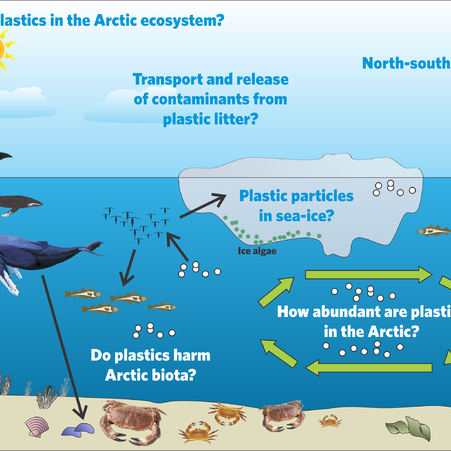24 February 2018 press release
Marine litter knows no borders
Scientists are now finding plastic debris in all Arctic marine habitats – along the coasts, at the surface, in the water column, in sea ice and on the sea floor. Scientific models are predicting a sixth major plastic garbage patch forming in the Barents Sea between Novaya Zemlya, Franz Josef Land and Svalbard.
Plastics, large and small
Senior scientist Dorte Herzke from NILU – Norwegian Institute for Air Research and Claudia Halsband, senior scientist at Akvaplan-niva, have conducted research on marine plastics for almost a decade. In the latest AMAP Assessment report, “Chemicals of Emerging Arctic Concern”, Herzke and Halsband provide a summary of what is currently known about marine plastics in the Arctic.
– Plastics are released into the environment from a range of different activities, says Halsband.
– Industrial activities such as commercial fishing, use of plastic abrasives, and spillage of plastic pellets are probably the main source for plastic ending up in the ocean. Domestic applications such as washing microfiber clothes, mismanaged waste and municipal wastewater also contribute to the pollution.
Where does marine plastic come from?
Marine plastics and microplastics find their way into the Arctic in different ways. Oceanographic models has shown that transport via ocean currents from more densely populated areas further south is highly likely. Water from the Atlantic entering the Arctic Ocean through the Fram Strait contains plastic debris, as well as other pollutants such as persistent organic pollutants (POPs) and heavy metals.
– In addition to this long-range transport, local sources also play a role, Herzke explains. – With more people living in and visiting the Arctic, more plastic products are being used. Add that to a changing climate which is causing damage to human constructions and releasing decade-old entrapped plastic debris from melting sea ice. The result is a potential for a future increase in marine plastic pollution in the Arctic.
Visible litter, invisible chemicals
At NILU and Akvaplan-niva, the scientists are looking into both what happens to microplastics in the environment and how microplastics affect the organisms that eat it.
– We know that marine plastics affect marine organisms in the whole ecosystem, says Herzke. –Scientists have found fish and other water dwelling organisms ingested by plastic since the 1970s. As of today, this is commonplace. In our studies, we find plastic and microplastics in both aquatic organisms and various types of sea birds all the time.
– It’s easy for people to see and understand marine litter in the form of visible plastic pieces on a beach or having created a wound causing the death of a bird, says Halsband. – It is more difficult to see the toxicological effects of plastic related chemicals or the effect of tiny pieces of plastic on small organisms such as plankton. We know very little about how the environmental conditions in the Arctic may affect the degradation of plastic to microplastic, and how vulnerable Arctic species are to this type of contamination. Thus, we need studies specific to Arctic conditions.
Want to learn more?
Claudia Halsband from Akvaplan-niva will co-convene a session on Plastic debris – pathways and impacts in arctic and boreal systems at the Norwegian Environmental Toxicology Symposium 14-16 March 2018 in Longyearbyen, Svalbard. Co-chairs of the session are Dorte Herzke (NILU – Norwegian Institute for Air Research), Martin Wagner (Norwegian University of Science and Technology) and Andy Booth (Sintef Ocean). At the event experts will discuss the state of knowledge about the distribution, fate, and ecological impacts of plastic debris in arctic and boreal ecosystems.
AMAP and emerging new pollutants in the Arctic
Since its establishment in 1991, the Arctic Monitoring and Assessment Programme (AMAP) has documented the extent and effects of pollution and climate change in the Arctic order to inform policy making.
Tens of thousands of chemicals are presently on the market and new substances continue to enter commerce each year. Though distantly located from industrialized centers and agricultural regions, the Arctic serves as "a sink" for global pollutants. The atmosphere, oceans and rivers transport the pollutants released at lower latitudes and deposit them in Arctic ecosystems.
Plastic debris travels to the Arctic along the same routes as other pollutants. Thus, both plastic and microplastics are emerging as a major environmental concern worldwide, including in the Arctic.
Dialogue between science and management
While the new AMAP report is an important tool to inform policy makers about the status of contaminants and plastic litter in the Arctic, it remains equally important to establish and maintain direct communication channels between the science community and environmental management agencies.
– The gap between research and the management of plastic pollution in the Arctic needs to be closed, said Climate and Environment minister Ola Elvestuen at a seminar at the conference Arctic Frontiers in January this year.
Seminar participants from the Fram Centre, the Research Council of Norway and other stakeholders emphasized the need for collaboration across science, policy and industry. Fridtjof Unander from the Research Council of Norway suggested to establish a “Plast21” program, where plastic pollution in the north can be discussed, studied and results disseminated to assist manager in taking the necessary actions.
By Christine F. Solbakken, NILU

